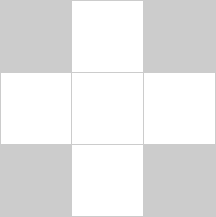
i
i
i
i
i
i
i
i
16
Brian Wyvill
Implicit Modeling
Implicit modeling (also known as implicit surfaces) in computer graphics covers
many different methods for defining models. These include skeletal implicit mod-
eling, offset surfaces, level sets, variational surfaces,andalgebraic surfaces.In
this chapter we briefly touch on these methods and describe how to build skeletal
implicit models in more detail. Curves can be defined by implicit equations of the
form
f(x, y)=0.
If we consider a closed curve, such as a circle, with radius r, then the implicit
equation can be written as
f(x, y)=x
2
+ y
2
− r
2
=0. (16.1)
The value of f (x, y) can be positive (outside the circle), negative (inside the
circle), or zero for points precisely on the circle. The equivalent in three dimen-
sions is a closed surface around a set of points that occupy a given volume or
region of space. The volume forms a scalar field, i.e., we can compute a value for
every point and as can be seen for the circle, the negative values are bounded by
the implicit curve or surface. The surface can be visualized as a contour in the
field, connecting points with a particular value such as zero (see Equation (16.1)).
To compute such a surface implies searching through space to find the points that
satisfy the implicit equation; this method is unlikely to lead to an efficient al-
gorithm for circle drawing (and even less likely in three dimensions). This was
perhaps the reason that algorithmic methods for modeling with parametric curves
385

i
i
i
i
i
i
i
i
386 16. Implicit Modeling
and surfaces were investigated before implicit methods; however, there are some
good reasons to develop algorithms to visualize implicit surfaces. Chapter 28
mentions scalar fields in the context of volume visualization. In this chapter we
explore the implications of deriving the data from a modeling process rather than
from a scanner.
Despite the computational overhead of finding the implicit surface, designing
with implicit modeling techniques offers some advantages over other modeling
methods. Many geometric operations are simplified using implicit methods in-
cluding:
• the definition of blends;
• the standard set operations (union, intersection, difference, etc.) of con-
structive solid geometry (CSG);
• functional composition with other implicit functions (e.g., R-functions,
Barthe blends, Ricci blends, and warping);
• inside/outside tests, (e.g., for collision detection).
Visualizing the surfaces can be done either by direct ray tracing using an algorithm
as described in (Kalra & Barr, 1989; Mitchell, 1990; Hart & Baker, 1996; deGroot
& Wyvill, 2005) or by first converting to polygons (Wyvill et al., 1986).
One of the first methods was proposed by Ricci as far back as 1973 (Ricci,
1973), who also introduced CSG in the same paper. Jim Blinn’s algorithm for
Figure 16.1. Blinn’s
Blobby Man 1980.
Image
courtesy Jim Blinn.
finding contours in electron density fields, known as Blobby molecules (J. Blinn,
1982), Nishimura’s Metaballs (Nishimura et al., 1985) and Wyvills’ Soft Ob-
jects (Wyvill et al., 1986) were all early examples of implicit modeling meth-
ods. Jim Blinn’s Blobby Man (see Figure 16.1) was the first rendering of a non-
algebraic implicit model.
16.1 Implicit Functions, Skeletal Primitives
and Summation Blending
In the context of modeling an implicit function is defined as a function f applied
to a point p ∈ E
3
yielding a scalar value ∈ R.
The implicit function f
i
(x, y, z) may be split into a distance function
d
i
(x, y, z) and a fall-off filter functio n
1
g
i
(r),wherer stands for the distance
from the skeleton and the subscript refers to the ith skeletal element.
1
These functions have been given many names by researchers in the past, e.g., filter, potential,
radial-basis, kernel, but we use fall-off filter as a simple term to describe their appearance.
Get Fundamentals of Computer Graphics, 3rd Edition now with the O’Reilly learning platform.
O’Reilly members experience books, live events, courses curated by job role, and more from O’Reilly and nearly 200 top publishers.

